#Salesforce Data Storage Management Best Practices
Explore tagged Tumblr posts
Text
Salesforce Data Archiving: Best Practices

Relevant business data is your “ace of spades”. To use it for achieving a competitive edge & business visibility, you need to first have it in your deck. Data is crucial for organizations to make business decisions based on facts and for more accurate targeting. One of the most significant ways of operating a business today is by managing the large data volume and identifying less used data that can be archived to a safe and secure storage location for future use. Read More
3 notes
·
View notes
Text
CRM Integration with Sales and Marketing Tools: Best Practices for Dubai Businesses
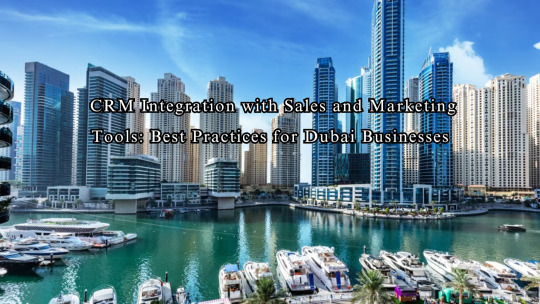
In today’s competitive digital landscape, Dubai-based businesses are rapidly embracing Customer Relationship Management (CRM) systems to stay ahead. But simply having a CRM isn’t enough. The real value emerges when your CRM is seamlessly integrated with your sales and marketing tools. This integration not only improves operational efficiency but also drives better customer engagement, enhances lead conversion, and maximizes ROI.
Why CRM Integration Matters in Dubai’s Market
Dubai’s diverse and fast-evolving business ecosystem requires a proactive approach to customer engagement. By integrating CRM with your existing sales and marketing platforms—such as email marketing tools, social media, and eCommerce solutions—you create a unified system that delivers:
Real-time customer insights
Automated lead nurturing
Consistent customer experiences
Smarter sales forecasting
Let’s explore best practices to help Dubai businesses successfully integrate CRM systems with sales and marketing tools.
1. Identify Business Objectives and KPIs
Before integrating your CRM with other platforms, define clear goals. Are you trying to shorten your sales cycle? Improve customer retention? Increase email campaign conversion rates? Identifying key performance indicators (KPIs) helps you evaluate the success of your integration and prioritize the right tools.
2. Choose the Right CRM Platform
Not all CRMs offer the same level of flexibility or compatibility. Dubai businesses should opt for CRM platforms that offer robust integration capabilities with popular sales and marketing tools like:
HubSpot
Salesforce
Zoho CRM
Microsoft Dynamics 365
Make sure the CRM supports API access or native integrations with the tools you currently use or plan to use.
3. Connect Your Email Marketing Tools
Integrating email marketing platforms (like Mailchimp or ActiveCampaign) with your CRM allows for:
Automated list segmentation
Personalized email campaigns
Real-time campaign tracking and reporting
This ensures that your marketing and sales teams work from a single source of truth, resulting in better alignment and improved communication.
4. Sync with Social Media and Advertising Platforms
Dubai’s consumer base is highly active on platforms like Instagram, LinkedIn, and Facebook. By connecting your CRM with these platforms, you can:
Track customer interactions across channels
Capture leads from social media ads directly into your CRM
Monitor engagement levels to refine marketing strategies
Tools like Meta Ads Manager, LinkedIn Lead Gen Forms, and Google Ads can often be integrated directly or through middleware like Zapier.
5. Automate Lead Scoring and Nurturing
CRM integration allows sales and marketing teams to automate lead scoring based on behaviors such as email opens, clicks, website visits, or form submissions. These scores can trigger personalized follow-ups, increasing the chances of conversion.
6. Ensure Data Accuracy and Synchronization
Data silos can lead to miscommunication and lost opportunities. It’s essential to regularly sync and clean your data to avoid duplicates, outdated contacts, or incorrect customer information. Automate synchronization processes to maintain real-time accuracy.
7. Train Your Team and Monitor Usage
The success of CRM integration depends on how well your team uses it. Offer training sessions tailored to sales and marketing teams to ensure they understand the integrated tools and workflows. Regularly review performance reports to identify areas of improvement.
8. Stay Compliant with UAE Data Laws
With increasing emphasis on data protection and digital privacy, Dubai businesses must ensure their CRM and integrated tools comply with UAE data protection regulations. Choose platforms that offer secure data storage and privacy features.
Conclusion
CRM integration with sales and marketing tools is not just a tech upgrade—it’s a strategic move that can redefine how Dubai businesses connect with their customers. By following best practices like selecting the right CRM, automating processes, and aligning team efforts, companies can gain a competitive edge in Customer Management System Dubai engagement and business growth.
0 notes
Text
Exploring the Role of Azure Data Factory in Hybrid Cloud Data Integration

Introduction
In today’s digital landscape, organizations increasingly rely on hybrid cloud environments to manage their data. A hybrid cloud setup combines on-premises data sources, private clouds, and public cloud platforms like Azure, AWS, or Google Cloud. Managing and integrating data across these diverse environments can be complex.
This is where Azure Data Factory (ADF) plays a crucial role. ADF is a cloud-based data integration service that enables seamless movement, transformation, and orchestration of data across hybrid cloud environments.
In this blog, we’ll explore how Azure Data Factory simplifies hybrid cloud data integration, key use cases, and best practices for implementation.
1. What is Hybrid Cloud Data Integration?
Hybrid cloud data integration is the process of connecting, transforming, and synchronizing data between: ✅ On-premises data sources (e.g., SQL Server, Oracle, SAP) ✅ Cloud storage (e.g., Azure Blob Storage, Amazon S3) ✅ Databases and data warehouses (e.g., Azure SQL Database, Snowflake, BigQuery) ✅ Software-as-a-Service (SaaS) applications (e.g., Salesforce, Dynamics 365)
The goal is to create a unified data pipeline that enables real-time analytics, reporting, and AI-driven insights while ensuring data security and compliance.
2. Why Use Azure Data Factory for Hybrid Cloud Integration?
Azure Data Factory (ADF) provides a scalable, serverless solution for integrating data across hybrid environments. Some key benefits include:
✅ 1. Seamless Hybrid Connectivity
ADF supports over 90+ data connectors, including on-prem, cloud, and SaaS sources.
It enables secure data movement using Self-Hosted Integration Runtime to access on-premises data sources.
✅ 2. ETL & ELT Capabilities
ADF allows you to design Extract, Transform, and Load (ETL) or Extract, Load, and Transform (ELT) pipelines.
Supports Azure Data Lake, Synapse Analytics, and Power BI for analytics.
✅ 3. Scalability & Performance
Being serverless, ADF automatically scales resources based on data workload.
It supports parallel data processing for better performance.
✅ 4. Low-Code & Code-Based Options
ADF provides a visual pipeline designer for easy drag-and-drop development.
It also supports custom transformations using Azure Functions, Databricks, and SQL scripts.
✅ 5. Security & Compliance
Uses Azure Key Vault for secure credential management.
Supports private endpoints, network security, and role-based access control (RBAC).
Complies with GDPR, HIPAA, and ISO security standards.
3. Key Components of Azure Data Factory for Hybrid Cloud Integration
1️⃣ Linked Services
Acts as a connection between ADF and data sources (e.g., SQL Server, Blob Storage, SFTP).
2️⃣ Integration Runtimes (IR)
Azure-Hosted IR: For cloud data movement.
Self-Hosted IR: For on-premises to cloud integration.
SSIS-IR: To run SQL Server Integration Services (SSIS) packages in ADF.
3️⃣ Data Flows
Mapping Data Flow: No-code transformation engine.
Wrangling Data Flow: Excel-like Power Query transformation.
4️⃣ Pipelines
Orchestrate complex workflows using different activities like copy, transformation, and execution.
5️⃣ Triggers
Automate pipeline execution using schedule-based, event-based, or tumbling window triggers.
4. Common Use Cases of Azure Data Factory in Hybrid Cloud
🔹 1. Migrating On-Premises Data to Azure
Extracts data from SQL Server, Oracle, SAP, and moves it to Azure SQL, Synapse Analytics.
🔹 2. Real-Time Data Synchronization
Syncs on-prem ERP, CRM, or legacy databases with cloud applications.
🔹 3. ETL for Cloud Data Warehousing
Moves structured and unstructured data to Azure Synapse, Snowflake for analytics.
🔹 4. IoT and Big Data Integration
Collects IoT sensor data, processes it in Azure Data Lake, and visualizes it in Power BI.
🔹 5. Multi-Cloud Data Movement
Transfers data between AWS S3, Google BigQuery, and Azure Blob Storage.
5. Best Practices for Hybrid Cloud Integration Using ADF
✅ Use Self-Hosted IR for Secure On-Premises Data Access ✅ Optimize Pipeline Performance using partitioning and parallel execution ✅ Monitor Pipelines using Azure Monitor and Log Analytics ✅ Secure Data Transfers with Private Endpoints & Key Vault ✅ Automate Data Workflows with Triggers & Parameterized Pipelines
6. Conclusion
Azure Data Factory plays a critical role in hybrid cloud data integration by providing secure, scalable, and automated data pipelines. Whether you are migrating on-premises data, synchronizing real-time data, or integrating multi-cloud environments, ADF simplifies complex ETL processes with low-code and serverless capabilities.
By leveraging ADF’s integration runtimes, automation, and security features, organizations can build a resilient, high-performance hybrid cloud data ecosystem.
WEBSITE: https://www.ficusoft.in/azure-data-factory-training-in-chennai/
0 notes
Text
What to Expect When You Hire a Salesforce Developer

One of the most effective CRM systems on the market, Salesforce helps companies increase revenue, enhance client connections, and automate procedures. To get the most out of it, you need a knowledgeable Salesforce developer who can adapt and enhance the platform to your company's requirements.
Knowing what to anticipate when hiring Salesforce developers will help the hiring process run more smoothly and efficiently, regardless of whether you're a budding startup or one of the many SaaS organizations that depend on Salesforce for client management. Let’s look into what you should expect when you are hiring these experts.
Key Responsibilities of a Salesforce Developer
The task of designing, modifying, and maintaining your CRM system falls down to a Salesforce developer. What to anticipate from them is as follows:
Customization & Development: Develop bespoke applications, alter Salesforce functionality, and establish workflows.
Integration with Other solutions: Link Salesforce to external applications such as ERP and marketing automation solutions.
Apex & Visualforce Development: Create unique code to add functionality to Salesforce.
Data Management & Security: Make sure that the right procedures are followed for data migration, storage, and security.
Better data insights, increased automation, and a smooth customer journey are all benefits of having a well-optimized CRM system for SaaS organizations.
Essential Skills to Look for When Hiring
Make sure the Salesforce developers you hire have:
Salesforce Platform Experience: Practical understanding of Marketing, Service, and Sales Cloud.
Development of Apex and Lightning Components: The capacity to create unique scripts for sophisticated features.
Knowledge of APIs and Integration: Proficiency in integrating Salesforce with external technologies.
Problem-Solving Skills: Ability to troubleshoot and optimize processes for increased productivity.
You might also need to hire software developers to collaborate with your Salesforce team if you require more experience with software-related integrations.
Where to Find Skilled Salesforce Developers
The following are some options for selecting the best Salesforce developer:
Freelance Platforms: Upwork, Toptal, and other websites provide contract developers.
Job Portals: Indeed, Glassdoor, and LinkedIn are excellent resources for full-time hires.
Hiring Platforms: Go a step beyond IT staffing agencies and find top pre-vetted Salesforce specialists with hiring platforms like Uplers. They have been shortlisted from the 1.5M+ talent network using AI and human evaluation.
Your project requirements, financial constraints, and whether you require short-term or long-term assistance will all influence your choice of talent sourcing platforms.
The Cost of Hiring a Salesforce Developer
Salesforce developers salary varies according to project complexity, geography, and expertise. Among the elements that affect the pay are:
Experience Level: While junior coders charge less, seasoned experts are more valuable.
Location: Salary expectations change if developers are hired from different areas.
Project Scope: Basic adjustments are less expensive than extensive Salesforce connections.
You can locate the greatest fit for your budget and navigate pay expectations by utilizing the Uplers salary analysis tool. This salary benchmarking tool can help you stay updated with the real-time salary insights so that you can align your offering with the industry benchmarks.
Concluding Thoughts
Hiring a Salesforce developer is an investment in the productivity and expansion of your company. Making the correct hiring decision guarantees long-term success. A CRM system that is properly installed is essential to scale the operations and provide excellent client experiences for your SaaS business.
0 notes
Text
What is Large Data Volumes (LDV) in Salesforce

In today's fast-paced digital world, businesses generate and manage an enormous amount of data. Salesforce, a leading CRM platform, helps organizations store, analyze, and utilize this data effectively. However, handling Large Data Volumes (LDV) in Salesforce presents unique challenges that require careful planning and strategic implementation. In this blog, we will explore LDV in Salesforce, best practices for managing it, and how businesses can optimize performance by leveraging expert Salesforce consulting in Sydney.
What is Large Data Volume (LDV)?
Large Data Volume (LDV) refers to datasets that contain millions (or even billions) of records. These massive datasets can impact Salesforce performance, leading to slow queries, inefficient reporting, and increased storage costs. Effective LDV management ensures smooth operations, optimized workflows, and improved user experience.
Challenges of Managing LDV in Salesforce
Organizations that deal with LDV often face several challenges, including:
Performance Issues: Large data volumes can slow down record retrieval, report generation, and dashboard performance.
Storage Constraints: Salesforce has storage limitations, and exceeding these limits can lead to additional costs.
Data Archiving: Retaining historical data without cluttering the active database requires proper archiving strategies.
Data Skew: Uneven data distribution can cause system inefficiencies and performance bottlenecks.
Search and Indexing Issues: Without proper indexing, querying large datasets can become time-consuming and inefficient.
Best Practices for Managing LDV in Salesforce
To overcome these challenges, businesses can implement the following best practices:
1. Optimize Data Architecture
Use custom indexes for frequently queried fields.
Implement skinny tables to speed up complex queries.
Use partitioning strategies to break down data into manageable chunks.
2. Implement Data Archiving Strategies
Archive old records that are no longer in active use.
Move historical data to external storage solutions or data warehouses.
Utilize Big Objects to store high-volume data efficiently.
3. Use Asynchronous Processing
Implement batch processing for handling large-scale data operations.
Leverage queueable Apex and future methods for background processing.
Use Salesforce Data Loader and ETL tools for bulk data operations.
4. Optimize Search and Queries
Avoid SOQL queries within loops to prevent performance issues.
Use indexed fields for filter conditions to speed up searches.
Implement Selective SOQL Queries to limit the number of returned records.
5. Leverage Salesforce Expertise
Engage with experienced Salesforce consultants in Sydney who can provide tailored solutions for LDV management.
Conduct regular performance audits and implement best practices to enhance efficiency.
Utilize Salesforce Shield for enhanced security and compliance in LDV environments.
Why Choose Professional Salesforce Consulting in Sydney?
Managing LDV in Salesforce requires specialized expertise to ensure scalability, performance, and cost-efficiency. Businesses in Australia can benefit significantly from engaging a Salesforce consultant in Sydney who understands local industry challenges and best practices. Professional consultants provide:
Customized solutions tailored to your business needs.
Performance tuning and optimization strategies for handling LDV effectively.
Data governance and security compliance recommendations.
Conclusion
Handling Large Data Volumes in Salesforce is a critical aspect of maintaining an efficient and scalable CRM system. By implementing best practices such as optimized data architecture, archiving strategies, asynchronous processing, and expert guidance, businesses can ensure seamless data management. For companies looking to enhance their Salesforce performance, partnering with a trusted Salesforce consultant in Sydney can be a game-changer.
If your organization is struggling with LDV challenges, consider reaching out to expert Salesforce consulting in Melbourne to streamline your data strategy and maximize Salesforce efficiency.
#salesforce consultant in Sydney#salesforce consulting in Sydney#salesforce partner in Sydney#salesforce consultants in Sydney#salesforce developer in Sydney#salesforce consultant in melbourne#salesforce consulting in melbourne#salesforce partner in melbourne#salesforce consultants in melbourne#salesforce developer in melbourne
0 notes
Text
Essential Tools for Streamlining Your Client Onboarding Process

1. CRM Tools for Centralized Client Management
Customer Relationship Management (CRM) tools like HubSpot, Salesforce, and Zoho CRM are indispensable for managing client information effectively. These tools help:
Organize client contact details and communication history.
Set up automated follow-ups and reminders.
Track the status of onboarding tasks.
By using a CRM, your PPC services team in Pune can maintain a centralized system, ensuring that no client details are overlooked during onboarding.
2. Project Management Tools
Platforms like Trello, Asana, or Monday.com streamline task assignment and tracking. For a PPC agency, these tools can be used to:
Create detailed onboarding checklists.
Assign tasks to specific team members, such as account setup or keyword research.
Monitor progress in real time.
These tools ensure that all onboarding activities are completed promptly and systematically.
3. Proposal and Contract Management Software
Using tools like PandaDoc or DocuSign simplifies the creation and signing of contracts. Key features include:
Customizable templates for proposals and agreements.
E-signature capabilities for faster approvals.
Real-time tracking of document status.
With these tools, your PPC services team can reduce delays and ensure all formalities are completed efficiently.
4. Communication Platforms
Effective communication is the cornerstone of a smooth onboarding process. Tools like Slack, Microsoft Teams, or Zoom enable real-time collaboration by offering:
Instant messaging for quick queries.
Video conferencing for detailed discussions.
Channels dedicated to specific clients or projects.
These platforms keep communication transparent and ensure that clients feel involved from the start.
5. Data Collection and Reporting Tools
Collecting relevant data is critical during onboarding to create effective PPC campaigns. Tools like Google Forms, Typeform, or Jotform help gather:
Business goals and target audience details.
Budget preferences and campaign objectives.
Login credentials for ad platforms.
This ensures your PPC services in Pune are customized to meet each client’s unique requirements.
6. Advertising Platform Setup Guides
Onboarding often involves setting up or auditing ad accounts. Tools like Google Ads Editor or Facebook Business Suite streamline account setup and campaign management. They allow you to:
Verify proper account configurations.
Set up billing information.
Optimize ad account settings based on industry best practices.
Ensuring these setups are flawless minimizes errors and enhances campaign performance.
7. File Sharing and Collaboration Tools
Tools like Google Drive, Dropbox, or OneDrive make it easy to share important documents and creative assets with clients. Features include:
Secure storage for sensitive information.
Real-time editing and collaboration.
Easy access to files from any device.
These tools keep all parties on the same page, ensuring transparency and efficiency.
8. Analytics and Reporting Tools
To build trust with clients, offer clear insights into campaign performance from day one. Tools like Google Analytics, SEMrush, or Supermetrics provide:
Initial performance benchmarks.
Customized dashboards tailored to client needs.
Regular reporting to track campaign success.
Your PPC services in Pune can stand out by showcasing professionalism and data-driven decision-making during onboarding.
9. Training and Knowledge-Sharing Platforms
Educating clients about PPC strategies can foster collaboration. Tools like Loom or Thinkific help create and share:
Introductory videos explaining PPC concepts.
Tutorials on accessing reports and dashboards.
Guides for providing constructive feedback
These tools empower clients, making them feel more confident about their investment in your PPC services.
10. Automated Workflows
Automation tools like Zapier or Make (formerly Integromat) can connect various platforms, reducing manual effort. For example:
Automatically add client details from forms to your CRM.
Notify team members of new onboarding tasks.
Trigger follow-up emails to clients post-onboarding.
Automation saves time, allowing your team to focus on delivering exceptional PPC services in Pune.
Conclusion
An efficient onboarding process sets the tone for a successful partnership. By leveraging the right tools, you can ensure that your PPC services are delivered seamlessly, building trust and long-term client relationships. As a trusted provider of PPC services in Pune, Digital Rhetoric is dedicated to optimizing every aspect of the client experience. From onboarding to campaign execution, we use cutting-edge tools to deliver unparalleled results.
Ready to streamline your PPC campaigns? Visit our dedicated page: PPC Services in Pune and let’s take your business to new heights!
0 notes
Text
How Does a Salesforce Consultant Improve CRM Efficiency?
A Salesforce consultant plays a vital role in enhancing CRM (Customer Relationship Management) efficiency, enabling businesses to streamline processes, improve customer relationships, and maximize their return on investment. CRM efficiency is critical in helping companies manage customer data effectively, facilitate collaboration across teams, and automate repetitive tasks.

Here’s a breakdown of how a Salesforce consultant enhances CRM efficiency for organizations:
1. Tailored Implementation and Customization
One of the most valuable aspects of hiring a Salesforce consultant is their ability to customize the platform to fit the unique needs of a business. Rather than a one-size-fits-all approach, consultants evaluate the company’s workflows, customer interactions, and data requirements to design a CRM setup that aligns with these specific needs. By configuring Salesforce features like custom fields, workflows, and automation rules, consultants ensure that the CRM system enhances efficiency, optimally supports business operations, and boosts productivity.
2. Automating Repetitive Tasks
Salesforce offers extensive automation capabilities, but knowing which automation tools to use and how to implement them effectively can be challenging. A Salesforce consultant can set up and optimize these tools, including process builders, workflows, and flows, to automate routine tasks like follow-ups, lead assignments, and data entry. Automating repetitive tasks saves significant time for sales and support teams, allowing them to focus more on engaging with customers and closing deals rather than on administrative tasks. This boosts productivity across the organization and improves overall CRM efficiency.
3. Optimizing Data Management
Efficient data management is crucial for CRM success, as it impacts everything from lead generation to customer service. Salesforce consultants establish best practices for data entry, storage, and hygiene, ensuring that customer data is accurate, complete, and up-to-date. Consultants can also set up validation rules, duplicate management systems, and data cleanup processes to maintain data quality. High-quality data leads to better insights and more accurate reporting, enabling teams to make faster, data-driven decisions and improving overall CRM efficiency.
4. Integrating Salesforce with Other Business Systems
Most organizations use multiple software tools for different functions, such as ERP systems, email platforms, marketing automation tools, and accounting software. Salesforce consultants play a key role in integrating these tools with Salesforce, creating a unified system where data flows seamlessly between applications. By setting up integrations, consultants enable departments to access a single, comprehensive view of the customer, which improves collaboration, reduces data silos, and streamlines workflows across teams. The result is a more efficient CRM system that supports all facets of the business.
5. Enhancing User Adoption and Training
One often overlooked aspect of CRM efficiency is user adoption. No matter how well-configured Salesforce is, its efficiency hinges on users knowing how to use it effectively. Salesforce consultants provide tailored training and onboarding programs to ensure teams understand the platform’s features and best practices. They can also create role-specific training to equip each team with the exact tools and skills they need. Higher user adoption translates to smoother workflows, better data quality, and a more efficiently utilized CRM system overall.
6. Real-Time Reporting and Analytics Setup
Salesforce consultants help businesses maximize the power of CRM analytics by configuring real-time reporting and dashboards that align with key performance indicators. By setting up customized reports, consultants enable businesses to track essential metrics, identify trends, and spot potential bottlenecks in the sales or customer service pipeline. This level of visibility helps managers make informed decisions quickly, leading to more efficient processes and optimized performance across departments.
7. Providing Ongoing Support and Optimization
Salesforce is a dynamic platform with regular updates and new features. A Salesforce consultant offers ongoing support and optimization services, ensuring the CRM system stays aligned with changing business goals. As needs evolve, consultants can implement new features, adjust workflows, and troubleshoot issues. Continuous optimization keeps the system efficient, helping companies adapt quickly to changes in the market and customer expectations without disruption.
Conclusion
A Salesforce CRM analytics consultant is instrumental in transforming Salesforce into a powerful tool that drives CRM efficiency. From custom implementation and automation to data management and training, consultants provide the expertise needed to make the most of Salesforce’s capabilities. By optimizing workflows, enhancing data quality, and ensuring seamless integration with other tools, a Salesforce consultant enables businesses to improve CRM efficiency, reduce costs, and drive growth. For any organization aiming to leverage Salesforce for greater operational efficiency, a consultant’s guidance can make all the difference.
0 notes
Text
The Future of Cloud App Development: Unlocking Business Value
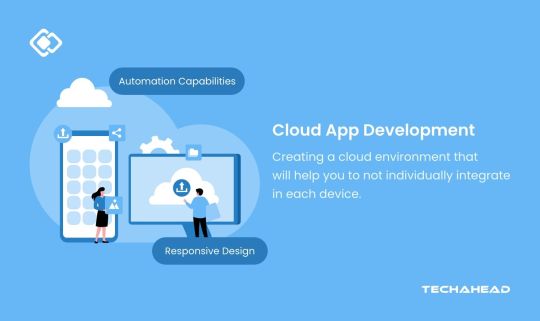
Cloud computing is rapidly transforming businesses. Many industry reports reveal that as business mobile applications grow, over 70% of digital workspaces face challenges with storage capacity and performance. The ideal solution to these issues is cloud app development, which provides unmatched scalability and flexibility.
Cloud app development simplifies data collection, enabling businesses to gather insights faster and more efficiently. It also enhances data security and streamlines management, making compliance and administration less burdensome. Cloud-powered development solutions empower businesses to create high-performance, productivity-focused applications that drive customer satisfaction and boost revenue.
Furthermore, cloud software solutions support low-code development, a time- and cost-efficient approach that minimizes extensive coding. This allows businesses to launch applications faster, optimizing resource usage and accelerating innovation cycles.
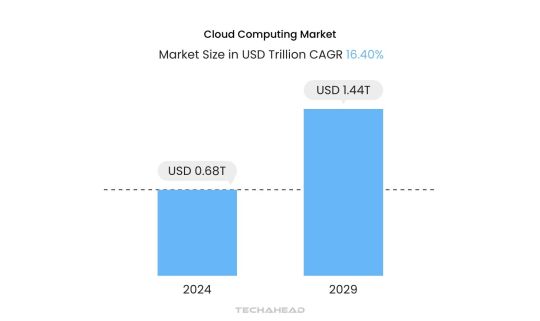
The cloud computing market is projected to grow substantially, with an estimated size of USD 0.68 trillion in 2024, anticipated to reach USD 1.44 trillion by 2029 at a CAGR of 16.40% (source: Mordor Intelligence). This robust growth highlights the rising demand for cloud solutions across industries. However, this rapid expansion in cloud applications prompts critical questions for businesses, especially around best practices in cloud app development.
In this guide, we’ll explore how to approach cloud app development effectively, the diverse cloud-based application solutions available, and how they drive value. You’ll gain insights into creating cloud applications that enhance operational efficiency, scalability, and customer engagement.
Let’s begin by examining the essentials that pave the way for efficient and future-ready cloud app development.
What is Cloud App Development?
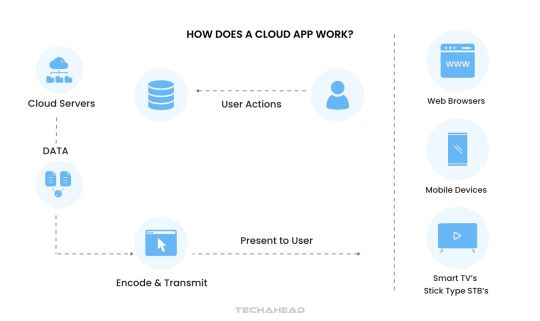
Cloud app development refers to creating applications within a cloud environment, bypassing the need for local servers. Unlike native applications, cloud-based apps rely extensively on cloud app development services, including data storage and processing, making them accessible through web browsers and other online platforms.
As enterprise development grows more reliant on cloud capabilities, they have leveraged its computational power to build groundbreaking solutions, transforming what’s possible in technology. Cloud services now empower companies to create a vast range of cloud applications that operate seamlessly on the web, often known as web apps.
These cloud apps are reshaping various business functions, taking over essential tasks like email, word processing, file storage, data collection, and even financial accounting. Through cloud app development, organizations are equipped with efficiency, streamline operations, and scale solutions like never before.
Types of Cloud App Development
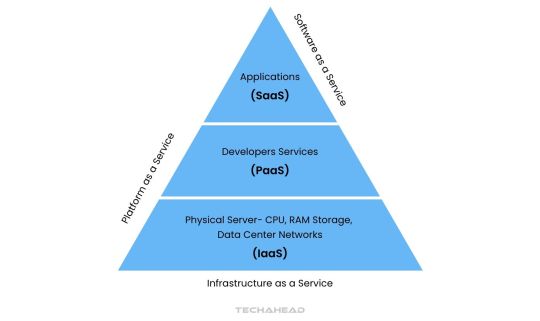
Software-as-a-Service (SaaS)
SaaS applications are hosted and maintained entirely by a cloud provider, making them accessible via the internet through web browsers. These applications relieve businesses from handling updates, server management, and software installations, as all maintenance is centrally managed by the provider. Users can seamlessly access features, integrate productivity tools, and share data across teams, which enhances operational efficiency.
Solutions like Google Workspace, Salesforce, and Slack exemplify SaaS by providing essential tools for collaboration, sales, and project management within a single, easily accessible platform.
Platform-as-a-Service (PaaS)
PaaS offers a managed environment for application development, which includes tools for building, testing, and deploying software while the cloud provider oversees infrastructure. By managing hardware and backend services, PaaS enables development teams to focus solely on cloud app development without the burden of configuring servers or databases. This platform accelerates time-to-market and streamlines scaling since the underlying resources are automatically adjusted as demand increases.
Examples like Microsoft Azure App Services and Google App Engine give developers robust frameworks and APIs, helping them build complex applications with minimal operational overhead.
Infrastructure-as-a-Service (IaaS)
IaaS delivers essential computing infrastructure such as virtual servers, storage, and networking resources. Unlike traditional on-premises infrastructure, IaaS allows businesses to pay for only the resources they use, which is ideal for scaling and managing large workloads flexibly. This model offers extensive control over the infrastructure, enabling IT teams to customize their environments and manage systems as needed.
Leading providers like AWS, Azure, and Google Cloud Platform provide services that allow companies to extend, scale, and secure their infrastructure easily, aligning with cloud app development needs for flexibility and resilience.
Function-as-a-Service (FaaS)
FaaS is part of serverless computing, allowing developers to deploy discrete code functions triggered by specific events, like user actions or system updates. With FaaS, there’s no need to manage or scale servers manually; the cloud provider handles it automatically based on demand. This model is ideal for applications requiring quick responses to high volumes of concurrent events, as it enhances cost efficiency and operational simplicity.
Popular FaaS services include AWS Lambda and Google Cloud Functions, which cater to cloud app development that prioritizes lightweight, highly scalable, and event-driven functionality.
Container-as-a-Service (CaaS)
CaaS leverages containers—lightweight, portable units of software that package application code along with its dependencies—for more efficient deployment and scaling across different environments. This model is highly beneficial for businesses adopting microservices architectures, as containers improve consistency in app deployment from development to production. CaaS platforms utilize orchestration tools, like Kubernetes, to automate the deployment, scaling, and management of containerized applications across multiple cloud or on-premises environments.
CaaS aligns with cloud app development demands for agility, allowing applications to scale seamlessly across hybrid or multi-cloud setups without compatibility issues.
Features of Every Cloud App Development Should Have
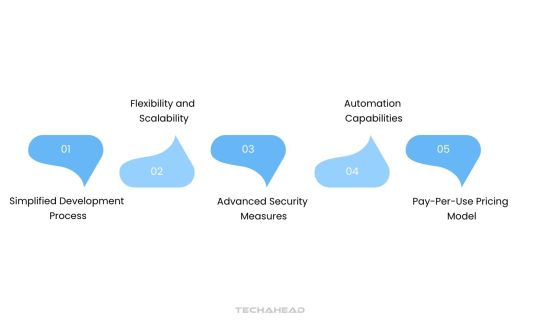
Simplified Development Process
An effective cloud app development platform should prioritize speed and simplicity. It should streamline architectural decisions, reducing complexity in creating and deploying applications across diverse technical environments. This simplicity allows hired developers to address challenges faster, minimizing errors and accelerating deployment. An efficient platform optimizes the overall development workflow, making it seamless to launch applications that meet high standards across various infrastructures.
Flexibility and Scalability
In cloud app development, flexibility is paramount. A robust platform should allow users to easily scale resources—adding or removing computing power, storage, and networking assets as demands fluctuate. Through automated scaling, these platforms adapt to dynamic workloads, preventing bottlenecks while ensuring optimal performance. During peak demand, a well-configured platform should instantly increase resources, and when demand lessens, it should scale down, maximizing cost-efficiency and resource allocation.
Advanced Security Measures
Security in cloud app development is a core feature, as cloud platforms employ top-tier security experts dedicated to threat management. These platforms adhere to stringent security protocols, often exceeding the protection provided by in-house teams. With compliance measures integrated, organizations can meet industry and governmental regulations effortlessly. Notably, 91% of companies report improved regulatory compliance post-cloud migration, emphasizing the cloud’s ability to safeguard data and ensure confidentiality.
You can also learn about the pillars of AI security and how it is protecting future technology.
Automation Capabilities
Automated processes are vital for managing complex, repetitive tasks in cloud app development. Advanced platforms support continuous integration and resource orchestration, which reduce operational burdens. Automation tools manage workload scaling, ensuring resources are available when needed without manual intervention. This allows IT teams to support growing demands efficiently while concentrating on strategic initiatives, enhancing overall operational efficiency.
Pay-Per-Use Pricing Model
A pay-per-use model enhances cost control within cloud app development, as users only pay for what they consume. This approach eliminates unnecessary expenses, allowing businesses to scale resources economically. Cloud providers track and report usage metrics, helping users monitor and optimize expenses. Some providers also offer a base level of free storage or computing power, making cloud resources even more accessible for startups and small businesses.
Steps to Take While Developing a Cloud App
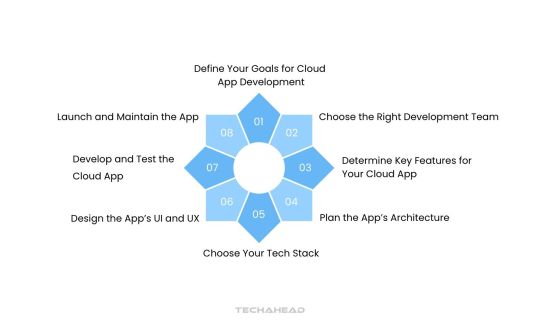
Creating a cloud app can involve web or mobile solutions, with the required technologies varying by solution type. Despite technical differences, the fundamental process in cloud app development follows similar phases to build a robust, user-centered application.
Step 1: Define Your Goals for Cloud App Development
Establishing clear objectives is crucial before development begins. Align all stakeholders on the project’s vision and goals during the discovery phase, helping the team understand the core business needs.
Reasons to consider cloud app development include:
Workflow automation: Streamlining repetitive tasks saves time and resources
Centralized data storage: Access and manage data easily within a single, organized environment.
Enhanced team collaboration: Improve internal communication and ensure seamless data exchanges.
Advanced reporting and analytics: Gain valuable insights to drive data-based decisions.
The discovery phase also allows developers to identify project scope, complexities, potential challenges, and costs. If a swift market entry is critical, a Minimum Viable Product (MVP) may be the best first step.
Step 2: Choose the Right Development Team
Cloud app development requires specialized skills, so selecting the right development team is essential. You can opt for freelancers, in-house talent, or outsource to a software development company.
Choosing a reliable cloud app development partner ensures ongoing support as the app evolves. Here are some questions to assess potential developers:
Can you share similar cloud app projects you have handled?
What platforms and technologies are you skilled in?
How do you prioritize security and scalability in development?
How do you approach cost management for cloud resources?
Can you ensure effective collaboration throughout the project?
A reliable development partner can adapt the app as technology advances and business needs grow.
Step 3: Determine Key Features for Your Cloud App
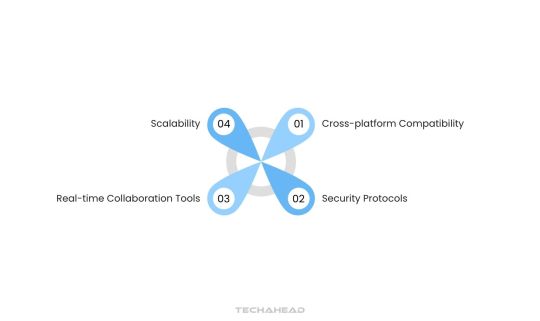
Identify core features that create a user-friendly experience in cloud applications. Essential features include:
Cross-platform compatibility: Allow users to access the app on their preferred devices.
Security protocols: Implement logins and access controls to protect user data.
Real-time collaboration tools: Enable users to work together through features like chat, live comments, and shared documents.
Scalability: Ensure the app can handle increasing users or workload.
Incorporating these features enhances user satisfaction and engagement, setting your app up for success.
Step 4: Plan the App’s Architecture
Your app’s architecture is the backbone of cloud app development, influencing scalability, security, and cost efficiency. Choose an architecture that aligns with your project’s requirements.
Key options include:
Monolithic architecture: A single, interconnected application; easy to develop but challenging to scale.
Microservices architecture: Divides the app into independent services; highly scalable but may face performance trade-offs.
Serverless architecture: Uses event-triggered functions in a serverless environment, ideal for low-maintenance, scalable solutions.
Hybrid architecture: Combines on-premises and cloud resources for high flexibility but may involve integration complexities.
Select an architecture that best aligns with your cloud app development goals. You can also look into this guide on Serverless Vs. Microservices architecture.
Step 5: Choose Your Tech Stack
The technology stack determines how quickly, securely, and effectively the app functions. Different projects require different combinations of programming languages (e.g., Java, Python, Node.js), databases (e.g., MongoDB, Firebase), frameworks (e.g., React, Angular), and containers (e.g., Docker, Kubernetes).
For instance, a Python-based stack offers scalability and maintenance ease, while Ruby on Rails works well for prototyping and collaboration. Choose the right tech stack that aligns with your app’s performance and integration needs.
Step 6: Design the App’s User Interface (UI) and User Experience (UX)
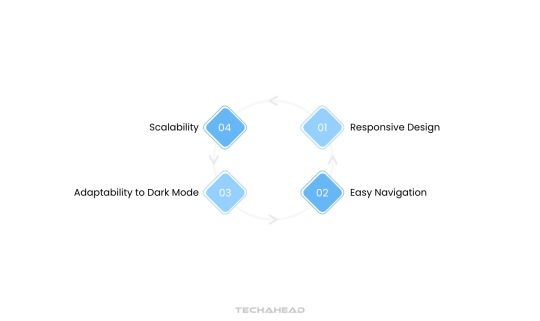
Effective UI/UX design is vital in cloud app development to create intuitive and visually appealing apps. Consider these elements:
Responsive design: Ensure seamless functionality across platforms and screen sizes.
Easy navigation: Users should quickly find what they need with minimal guidance.
Adaptability to dark mode: Offer both light and dark modes to reduce eye strain.
Scalability: Design a UI that accommodates future growth and additional features.
A responsive, intuitive, and adaptable UI makes the app user-friendly and future-proof. You can learn more about the Mobile UI designs as well.
Step 7: Develop and Test the Cloud App
Cloud app development typically uses Agile or DevOps methodologies, depending on project needs and team preferences.
Agile development emphasizes short, iterative development cycles, with regular testing and feedback after each sprint. Agile promotes flexibility, allowing the team to adapt to evolving requirements.
DevOps fosters collaboration across development and operations, with a focus on Continuous Integration/Continuous Delivery (CI/CD) and automation for efficient testing and deployment.
Both approaches streamline development, but the choice depends on team readiness and project goals.
Step 8: Launch and Maintain the App
Successful cloud app development doesn’t end with deployment. Continuous maintenance keeps your app relevant, responsive, and secure. Essential areas include:
Security updates: Regular patches to safeguard user data.
Performance optimization: Keep the app fast and responsive as usage grows.
Scalability adjustments: Ensure the app scales efficiently as demand fluctuates.
Technology updates: Adapt the stack to new versions or libraries.
Ongoing maintenance ensures a secure, scalable, and high-performing cloud app that keeps pace with technological advancements and user expectations.
Benefits of Cloud App Development
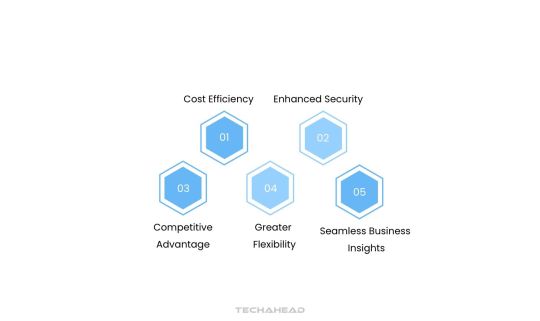
Cost Efficiency
Cloud app development significantly reduces costs by eliminating the need for on-premise infrastructure. With cloud-based applications, businesses only pay for the services they use, making it approximately 40% more affordable for small companies. This pay-as-you-go model means businesses can adjust monthly expenses based on usage, resulting in ongoing cost control.
Unlike traditional hardware, which requires significant upfront investment, cloud solutions offer flexible pricing that can scale with business growth. Additionally, many providers offer cost-saving options, like discounts on long-term contracts for larger enterprises.
You can learn more about the cost of app development.
Enhanced Security
Data security remains a huge priority when it comes to cloud app development. While integrating them, they tend to provide robust protection that safeguards sensitive information. Top cloud-based service providers employ advanced encryption techniques. It all helps in making it harder to get data accessibility for unauthorized users.
Even if there’s an intrusion attempt, encryption ensures data remains protected. Cloud hosting also includes 24/7 monitoring by specialized security teams, often surpassing the reliability of in-house systems. Research shows that 94% of businesses have reported enhanced data security after moving to cloud-based applications, demonstrating its effectiveness in managing data integrity and safety.
Competitive Advantage
Leveraging cloud app development gives companies a significant competitive edge. Cloud services handle infrastructure management, freeing up IT teams to focus on innovation and growth-centric initiatives. With a faster deployment cycle and access to the latest cloud technologies, cloud-enabled companies stay ahead in a rapidly evolving market.
Studies indicate that 77% of organizations find cloud technology helps maintain a competitive advantage. Cloud providers regularly update their offerings, allowing businesses to utilize state-of-the-art tools without needing continual hardware upgrades.
Greater Flexibility
Cloud app development introduces flexibility that in-house servers can’t match, especially in scaling resources. Teams no longer need to worry about storage or bandwidth limitations since cloud infrastructure can easily expand based on demand. This adaptability enables businesses to swiftly respond to changing market needs and to adjust resources during peak times. By outsourcing app development to cloud providers, in-house teams can focus on creating impactful solutions that directly support business objectives, fostering a more agile methodology, and resilient organization.
You can learn more about Offshore Vs. Onshore.
Seamless Business Insights
Current data-driven environment, the insights derived from cloud app development are invaluable. Cloud storage solutions offer powerful analytics tools that allow businesses to process and analyze data effortlessly. With these tools, businesses can gain actionable insights, create detailed reports, and use real-time data to enhance decision-making.
Conclusion
Cloud computing is transformative, future-ready technology that drives business scalability, efficiency, and sustainable growth. Leveraging cloud app development, companies startups or even established enterprises can significantly enhance performance, streamline operations, and cut down on overhead expenses.
Investing in cloud app development services is a strategic step for any business aiming to launch a resilient, next-gen mobile application. Given the technical expertise required for implementing cloud infrastructure in mobile applications, it’s advisable to engage skilled app developers with experience in startup solutions.
Source URL: https://www.techaheadcorp.com/blog/cloud-app-development-reaching-the-value-infection-point/
0 notes
Text
Power Apps Training | Power Automate Training
How to Integrate Power Apps Training with Third-Party Services Easily
Integrating Power Apps with third-party services is an essential skill that enables businesses to streamline processes and automate tasks efficiently. In today’s digital landscape, organizations are looking for low-code solutions to reduce dependency on traditional developers, and Power Apps Training provides the skills needed to build powerful applications that connect seamlessly with external services. Additionally, pairing Power Apps with Power Automate Training enhances automation capabilities, allowing for smooth integration with various tools and platforms. This article will guide you through how to integrate Power Apps with third-party services easily, using some practical examples and best practices.
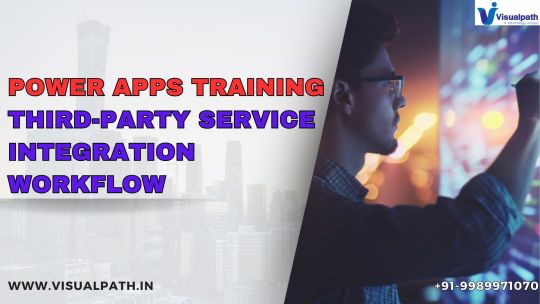
Understanding Power Automate Training for Seamless Integration
Integrating Power Apps with third-party services can be simplified using Power Automate. Power Automate Training enables users to automate repetitive tasks and workflows between different applications and services. For instance, you can connect Power Apps to services like SharePoint, Dynamics 365, Microsoft Teams, and even non-Microsoft services such as Salesforce, Dropbox, and Twitter.
When integrating third-party services, Power Automate acts as a bridge that automates tasks triggered by actions in Power Apps. For example, if you use Power Apps to capture data from users, Power Automate can be used to send that data to an external service, store it, or trigger another action. With the knowledge from Power Automate Training, you can configure these integrations without writing complex code.
Key Benefits of Power Apps Online Training for Third-Party Integrations
Completing Power Apps Online Training ensures that you understand how to connect your apps with multiple services using built-in connectors. There are over 500 connectors available in Power Apps, making it easy to integrate with both Microsoft and non-Microsoft platforms. Here are some key benefits of integrating Power Apps with third-party services:
Simplified Workflows: With connectors, Power Apps simplifies the process of integrating data and services. Users can quickly create apps that pull in information from multiple sources, such as databases, CRM systems, and file storage services.
Cost-Effective: Integration using Power Apps and Power Automate eliminates the need for custom APIs or heavy development efforts, saving both time and costs associated with traditional software development.
Scalability: Once you integrate Power Apps with third-party services, scaling becomes easier as connectors allow you to automate and manage larger volumes of data across multiple platforms.
Flexibility: With Power Apps Online Training, users can build apps tailored to specific business needs, ensuring that the integrations meet the unique requirements of your organization.
Steps to Integrate Power Apps with Third-Party Services
Choose a Connector: Start by selecting a connector that links Power Apps with the service you want to integrate. For example, if you are integrating with Salesforce, choose the Salesforce connector.
Set up a Flow in Power Automate: After selecting the connector, navigate to Power Automate and create a flow that triggers actions based on inputs from Power Apps. For instance, if a form is submitted in Power Apps, the flow can automatically save that data in Salesforce or any other integrated service.
Configure Permissions: Ensure that the third-party service has the correct permissions to access and interact with Power Apps. This may involve setting up OAuth authentication or API tokens.
Test and Monitor: Once the integration is set up, test it thoroughly. Use Power Automate to monitor the flow’s performance and ensure that the data is flowing correctly between Power Apps and the third-party service.
Best Practices for Learning Integration via Microsoft Power Apps Training Courses
Mastering the integration of Power Apps with third-party services requires continuous learning and hands-on practice. Enrolling in Microsoft Power Apps Training Courses will help you stay updated on new features, connectors, and integration techniques. Here are some best practices to keep in mind:
Start with Simple Integrations: Begin by integrating Power Apps with familiar services like Microsoft 365 or SharePoint. This will help you grasp the basics before moving on to more complex third-party services.
Use Pre-Built Templates: Microsoft Power Apps Training Courses often provide templates for common integrations. Use these templates to save time and ensure best practices are followed during the setup process.
Optimize Data Flow: When integrating with third-party services, ensure that the data flow is optimized. This means minimizing latency and ensuring that the app is not overloaded with unnecessary data transactions.
Security and Compliance: Always ensure that your integrations adhere to your organization's security policies. Protect sensitive data by using encryption and secure API connections.
Conclusion
Integrating Power Apps with third-party services is a powerful way to streamline workflows, automate tasks, and enhance business operations. By combining the knowledge from Power Apps Training with Power Automate Training, you can easily set up these integrations without the need for complex development work. Whether you are connecting Power Apps with Microsoft tools like Dynamics 365 or third-party platforms like Salesforce, the flexibility and ease of use provided by Power Apps and Power Automate ensure that your integrations are seamless and efficient.
To fully harness the potential of these tools, consider enrolling in Power Apps Online Training or Microsoft Power Apps Training Courses to gain hands-on experience and stay updated with the latest integration techniques. The skills you acquire will not only simplify third-party integrations but also empower you to create more dynamic, automated solutions for your business.
Visualpath is the Leading and Best Institute for learning in Hyderabad. We provide Power Apps and Power Automate Training. You will get the best course at an affordable cost.
Attend Free Demo
Call on – +91-9989971070
Visit: https://www.visualpath.in/online-powerapps-training.html
#Power Apps Training#Power Automate Training#Power Apps Online Training#Microsoft Power Apps Training#PowerApps Training Course#Power Apps and Power Automate Training#Power Apps Training in Hyderabad#Microsoft Power Apps Training Courses
1 note
·
View note
Text
Salesforce Migration Best Practices: Ensuring a Smooth Transition for Your Business with TechForce Services
In today’s fast-paced business environment, cloud-based CRM solutions like Salesforce are transforming how organizations manage customer relationships, sales processes, and data analytics. However, successfully transitioning to this platform requires expertise and strategic planning. That’s where TechForce Services comes in—offering Salesforce managed services that ensure a smooth migration and integration process, enabling your business to thrive with minimal disruption.
A well-executed Salesforce Migration involves more than just data transfer; it ensures seamless Salesforce integration with your existing systems while maintaining optimal platform performance. This blog outlines the best practices for a successful Salesforce Migration and highlights how TechForce Services can support your business throughout the journey.
Why Salesforce Migration Matters
Migrating to Salesforce can revolutionize how your business operates. It optimizes customer relationship management, streamlines sales processes, and provides deeper insights through advanced data analytics. But without a detailed migration strategy, you risk data loss, system downtime, and decreased user satisfaction. Adopting best practices for Salesforce Migration ensures that your transition is efficient and successful, unlocking the full potential of Salesforce for your organization.
Best Practices for a Successful Salesforce Migration with TechForce Services
1. Assess Your Current Systems
Before starting the migration process, it’s essential to evaluate your current CRM systems, data storage solutions, and other platforms. Analyzing your data structure, workflows, and system dependencies will help identify what needs to be migrated and ensure compatibility with Salesforce.
This assessment is also crucial for Salesforce integration, ensuring that Salesforce can seamlessly interact with tools such as marketing automation systems, financial software, and customer service platforms. TechForce Services can help with this critical evaluation, ensuring nothing is overlooked in your migration planning.
2. Clean and Organize Your Data
One of the most critical factors in Salesforce Migration is ensuring that you’re migrating clean and high-quality data. Transferring poor-quality or outdated data can lead to reporting inaccuracies, inefficient workflows, and frustration for end-users.
Before migrating, TechForce Services recommends thoroughly cleaning your data to eliminate duplicates, irrelevant entries, and incorrect information. Organize data into logical structures and ensure it is properly formatted for Salesforce. This step helps minimize migration errors and allows your team to easily navigate the system post-migration.
3. Choose the Right Migration Strategy
TechForce Services offers expertise in selecting the most appropriate Salesforce Migration strategy based on the complexity of your current systems and business needs. There are three main migration strategies:
Big Bang Migration: A fast, one-time migration of all data and systems to Salesforce. While this approach reduces transition time, it carries higher risks if errors occur.
Phased Migration: Gradually migrates parts of your system over time, allowing for thorough testing and minimal disruption to daily operations.
Hybrid Migration: This approach balances speed and caution by migrating essential data first while taking a phased approach for other parts.
TechForce Services can help determine the best strategy for your organization, ensuring a successful migration with minimal risk.
4. Test and Validate the Migration
Once the initial migration is set up, testing is essential to ensure that everything runs smoothly before going live. Conduct a test migration with a smaller dataset to identify potential issues, such as data inconsistencies, integration problems, or workflow disruptions.
During this phase, ensure Salesforce integration with all your business tools is functioning as expected. Whether it’s connecting with marketing platforms or finance software, TechForce Services can help validate and test the integration to ensure a seamless experience. Data validation after the test migration is crucial to confirm that everything has been transferred correctly and is performing as required.
5. Train Your Team for a Smooth Transition
A smooth Salesforce Migration is not just about data and systems—it’s also about people. User adoption is critical to maximizing the value of your Salesforce platform. Ensure that your team is well-trained on the new system before, during, and after migration.
TechForce Services can provide tailored training sessions for your team, from basic Salesforce functionality to advanced features like Salesforce integration. Offering ongoing support and resources will help ensure your staff is confident and efficient in using the new system.
6. Leverage TechForce Services for Ongoing Support
After the migration is complete, continuous monitoring and optimization are essential for maintaining a healthy Salesforce environment. This is where Salesforce managed services from TechForce Services come in handy. Post-migration, their team can provide ongoing support to monitor system performance, troubleshoot issues, and optimize the platform for evolving business needs.
Additionally, TechForce Services ensures that your Salesforce integration remains seamless, providing necessary updates or improvements to keep your connected systems running smoothly. This level of support ensures that you’re always maximizing your Salesforce investment.
The Importance of Salesforce Integration
One of the primary objectives of any Salesforce Migration is ensuring effective Salesforce integration with other key business tools. Integration allows different systems within your organization—whether it’s marketing, finance, or customer support—to work harmoniously with Salesforce, boosting productivity and data accuracy.
For example, integrating Salesforce with your marketing automation platform allows for improved lead nurturing, while integration with accounting software enhances financial reporting and accuracy. By enabling systems to communicate efficiently, Salesforce integration streamlines operations and supports overall business goals.
Conclusion: Ensure a Smooth Salesforce Migration with TechForce Services
Migrating to Salesforce can be a transformative experience for your business, unlocking improved customer management, data-driven insights, and enhanced operational efficiency. However, without careful planning and expert support, the process can present challenges.
By following these best practices and partnering with TechForce Services, you can ensure a smooth, efficient Salesforce Migration. From data assessment and cleaning to seamless Salesforce integration and ongoing managed services, TechForce Services is your trusted partner for a successful Salesforce transition.
Call to Action: Ready to migrate to Salesforce with confidence? Contact TechForce Services today to learn how our Salesforce managed services can streamline your migration and deliver long-term benefits for your business!
0 notes
Text
5 Best Practices to Optimize Data Management in Salesforce Marketing Cloud

Salesforce Marketing Cloud is a powerful platform designed to enhance marketing efforts by providing comprehensive tools for managing customer data, automating campaigns, and gaining insights through analytics. Effective data management is crucial in leveraging these tools to their fullest potential, ensuring that marketing strategies are both efficient and effective.
Understanding Data Management in Salesforce Marketing Cloud
Data management in Salesforce Marketing Cloud involves the processes and technologies used to collect, store, manage, and analyze customer data. This includes everything from data collection and storage to integration, analysis, and security. Effective data management can lead to improved customer engagement, higher conversion rates, and a more personalized customer experience.
Key Components of Data Management
Key components of data management in Salesforce Marketing Cloud include data collection, data integration, data quality, data security, and data analysis. Each component plays a vital role in ensuring that the data used in marketing campaigns is accurate, secure, and actionable.
Benefits of Effective Data Management
Effective data management can lead to numerous benefits, including improved targeting and personalization, increased efficiency in marketing campaigns, enhanced customer insights, and better compliance with data regulations. By optimizing data management, businesses can make more informed decisions and achieve better outcomes from their marketing efforts.
Data Segmentation and Personalization
Data segmentation and personalization are critical practices in optimizing data management. By segmenting data, marketers can create more targeted and personalized campaigns that resonate with specific customer groups.
Importance of Data Segmentation
Data segmentation allows marketers to divide their customer base into distinct groups based on various criteria such as demographics, behavior, or purchase history. This enables more precise targeting and helps in delivering relevant content to different segments.
Techniques for Effective Segmentation
Effective segmentation can be achieved using various techniques, including demographic segmentation, psychographic segmentation, and behavioral segmentation. Salesforce Marketing Cloud experts recommend using tools within the platform to automate segmentation based on predefined rules and criteria.
Enhancing Personalization through Segmentation
Once data is segmented, personalization becomes much easier. Personalized content and offers can be tailored to each segment, increasing the likelihood of engagement and conversion. Personalization helps in building stronger relationships with customers and improving overall customer satisfaction.
Data Quality and Cleanliness
Maintaining high data quality and cleanliness is essential for effective data management. Poor data quality can lead to incorrect insights and ineffective marketing strategies.
Ensuring Data Accuracy and Consistency
Ensuring data accuracy and consistency involves regular data validation and standardization processes. This helps in maintaining the integrity of the data and ensures that marketing campaigns are based on reliable information.
Tools and Techniques for Data Cleaning
Salesforce Marketing Cloud offers various tools for data cleaning, including data deduplication and validation features. Regular data cleaning helps in removing duplicates, correcting errors, and standardizing data formats.
Regular Data Audits and Updates
Conducting regular data audits and updates is crucial for maintaining data quality. This involves reviewing data periodically to identify and rectify any inaccuracies or inconsistencies. Salesforce marketing cloud experts emphasize the importance of continuous monitoring and updating of data to ensure its reliability.
Data Integration and Synchronization
Integrating and synchronizing data from various sources ensures that marketers have a comprehensive view of their customers. This is crucial for creating unified and consistent marketing campaigns.
Integrating Data from Various Sources
Data integration involves combining data from different sources such as CRM systems, e-commerce platforms, and social media channels. Salesforce Marketing Cloud provides various connectors and APIs to facilitate seamless data integration.
Synchronizing Data Across Platforms
Synchronizing data across platforms ensures that all systems have access to the latest and most accurate data. This helps in maintaining consistency and accuracy in marketing campaigns.
Using APIs and Connectors
APIs and connectors play a vital role in data integration and synchronization. Salesforce Marketing Cloud experts recommend utilizing these tools to automate data flow between different systems, ensuring that data is always up-to-date and accurate.
Data Security and Compliance
Data security and compliance are paramount in data management. Protecting customer data and ensuring compliance with regulations is essential for building trust and avoiding legal issues.
Importance of Data Security
Data security involves protecting data from unauthorized access, breaches, and other threats. Implementing robust security measures helps in safeguarding customer information and maintaining their trust.
Implementing Security Measures
Security measures such as encryption, access controls, and regular security audits are essential for protecting data. Salesforce Marketing Cloud offers various security features to help businesses secure their data.
Ensuring Compliance with Regulations
Compliance with data regulations such as GDPR and CCPA is crucial for avoiding legal penalties and building trust with customers. Salesforce marketing cloud experts advise businesses to stay updated with regulatory changes and implement necessary compliance measures.
Utilizing Data Analytics and Reporting
Leveraging data analytics and reporting helps marketers gain valuable insights and make data-driven decisions. This enhances the effectiveness of marketing campaigns and improves overall business performance.
Leveraging Analytics for Better Insights
Data analytics involves analyzing data to identify trends, patterns, and insights. Salesforce Marketing Cloud provides various analytics tools that help marketers gain a deeper understanding of customer behavior and campaign performance.
Creating Effective Reports and Dashboards
Creating effective reports and dashboards enables marketers to visualize data and track key performance indicators (KPIs). This helps in monitoring campaign performance and making informed decisions.
Making Data-Driven Decisions
Data-driven decision-making involves using insights gained from data analytics to guide marketing strategies and tactics. Salesforce marketing cloud experts highlight the importance of relying on data rather than intuition for making marketing decisions.
Conclusion
Optimizing data management in Salesforce Marketing Cloud is essential for maximizing the effectiveness of marketing campaigns. By following these best practices—data segmentation and personalization, maintaining data quality and cleanliness, integrating and synchronizing data, ensuring data security and compliance, and utilizing data analytics and reporting—businesses can enhance their marketing efforts and achieve better outcomes. Leveraging the expertise of Salesforce Marketing Cloud experts can further streamline these processes and ensure successful implementation. With the right approach, businesses can unlock the full potential of their data and drive significant growth and success.
1 note
·
View note
Text
Building a Robust Cloud Computing Infrastructure: Key Insights and Best Practices
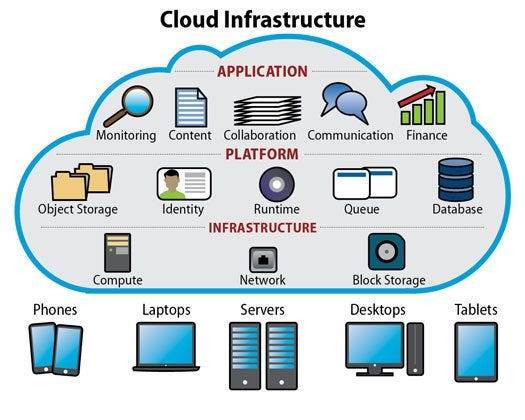
Cloud computing infrastructure consists of the hardware and software components — such as servers, storage, networking, and virtualization software — that are needed to support the computing requirements of a cloud computing model. It allows businesses to scale resources up or down as needed, ensuring cost efficiency and flexibility.
Understanding Cloud Computing Infrastructure
Cloud computing infrastructure refers to the combination of hardware and software components — such as servers, storage, networks, and virtualization software — that work together to support the delivery of cloud services. This infrastructure is foundational for deploying and managing applications and services in the cloud.
Essential Steps for Cloud Setup and Maintenance
#1. Planning Your Cloud Setup
Before diving into the technical aspects, it’s imperative to outline your business needs and goals. This includes:
- Assessing Requirements: Understand what applications and services need to be hosted on the cloud.
- Choosing the Right Cloud Model: Decide between public, private, or hybrid cloud models based on your security, compliance, and cost requirements.
- Budgeting: Allocate a budget for initial setup, ongoing maintenance, and potential scalability.
#2. Setting Up the Cloud Computing Infrastructure
Once planning is complete, follow these steps to establish your cloud computing infrastructure:
Select a Cloud Provider: Popular options include AWS, Microsoft Azure, and Google Cloud Platform. Evaluate them based on cost, features, and support.
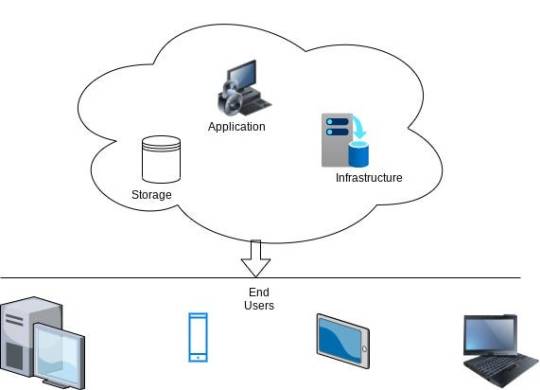
- Design the Infrastructure: This involves creating a blueprint of your cloud architecture, including networking, storage, and compute resources.
- Implement Security Measures: Ensure robust security protocols are in place to protect data and applications from threats. This includes firewalls, encryption, and identity management.
- Deploy Applications: Migrate your applications to the cloud environment. This might involve refactoring or re-architecting applications to optimize for cloud performance.
3. Cloud Maintenance Services
Maintaining your cloud environment is critical for ensuring performance, security, and cost-efficiency. Key aspects of cloud maintenance services include:
- Monitoring and Management: Regularly monitor cloud resources for performance issues and manage them to avoid disruptions.
- Security Updates and Patches: Keep your infrastructure secure by applying regular updates and patches.
- Backup and Disaster Recovery: Implement a robust backup strategy and ensure you have a disaster recovery plan in place.
- Cost Optimization: Continuously review and optimize your cloud spending to avoid unnecessary costs.
Implementing Salesforce Commerce Cloud Setup
For businesses looking to leverage Salesforce Commerce Cloud, the setup process involves:
- Initial Configuration: Set up the basic environment, including defining business settings, user roles, and permissions.
- Customizing the Platform: Tailor the platform to meet specific business needs through custom code, extensions, and integrations.
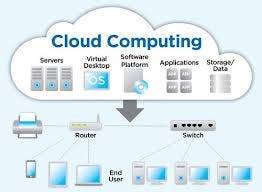
- Testing and Deployment: Thoroughly test the environment and applications before going live to ensure everything works seamlessly.
Conclusion
Building and maintaining a robust cloud computing infrastructure is pivotal for modern businesses aiming to achieve agility, scalability, and efficiency. Whether you’re setting up a new environment or optimizing an existing one, understanding the nuances of cloud setup and maintenance and leveraging professional cloud maintenance services can significantly enhance your operational capabilities. Embrace the power of Salesforce Commerce Cloud to drive your e-commerce initiatives forward, ensuring a seamless and secure cloud journey.
For a detailed guide on building a cloud computing infrastructure, visit [this comprehensive resource](https://experlabs.com/how-to-build-a-cloud-computing-infrastructure/).
0 notes
Text
0 notes
Text
Using Azure Data Factory for Government Data Pipelines

Introduction
Government agencies handle vast amounts of data, ranging from citizen records and tax information to law enforcement and healthcare data. Managing, processing, and integrating such data securely and efficiently is a significant challenge.
Azure Data Factory (ADF) provides a scalable, cloud-based ETL (Extract, Transform, Load) solution that enables government agencies to securely move and transform data while ensuring compliance with regulatory requirements. This blog explores how ADF can be leveraged for government data pipelines, key features, and best practices for secure data processing.
Why Azure Data Factory for Government Data?
1. Compliance with Government Regulations
Government agencies must adhere to strict data security and compliance requirements such as:
FedRAMP (Federal Risk and Authorization Management Program) — Ensuring cloud security for U.S. government agencies
GDPR (General Data Protection Regulation) — Protecting personal data of EU citizens
HIPAA (Health Insurance Portability and Accountability Act) — For handling healthcare data
CJIS (Criminal Justice Information Services) Compliance — Data protection for law enforcement agencies
Azure Data Factory supports compliance by offering role-based access control (RBAC), encryption, audit logging, and private network security to safeguard sensitive government data.
2. Secure and Scalable Data Movement
Government agencies often have hybrid infrastructures with data spread across on-premises servers, legacy systems, and cloud platforms. ADF facilitates seamless data movement and transformation across these environments while maintaining security through:
Self-Hosted Integration Runtimes for secure on-premises data access
Private Link to restrict network exposure
Built-in encryption (both at rest and in transit)
3. Integration with Multiple Data Sources
ADF supports integration with a wide range of structured and unstructured data sources, including:
SQL Server, Oracle, PostgreSQL (On-Premises and Cloud)
Azure Blob Storage, Azure Data Lake Storage
REST APIs, SAP, Salesforce, and more
This flexibility enables government agencies to centralize disparate datasets, ensuring seamless interoperability.
Key Features for Government Data Pipelines
1. Secure Data Integration
ADF enables secure data ingestion from multiple sources while enforcing access policies. Data transformation can be performed within Azure Synapse Analytics, Databricks, or other processing engines, ensuring compliance with government security standards.
2. Data Security & Governance
Managed Private Endpoints — Ensuring data does not traverse the public internet
Azure Policy & RBAC — Controlling who can access and manage data pipelines
Data Masking & Encryption — Protecting personally identifiable information (PII)
3. Automated Workflows & Monitoring
Government agencies require scheduled and event-driven data workflows for regulatory reporting and citizen services. ADF provides:
Triggers and Scheduling for automated ETL workflows
Monitoring & Logging with Azure Monitor for real-time visibility
Alerts & Notifications for pipeline failures
4. Hybrid Connectivity for Legacy Systems
Government organizations often rely on legacy systems that need modernization. ADF allows secure connectivity to on-premises databases and file servers using self-hosted integration runtimes, ensuring smooth data migration and transformation.
Use Cases of ADF in Government Data Processing
1. Citizen Services & Public Portals
Government portals require real-time data processing for services like tax filings, unemployment claims, and benefits distribution. ADF enables:
Data ingestion from APIs and databases for up-to-date citizen information
Data validation and transformation for accurate reporting
Integration with Power BI for visual analytics and dashboards
2. Regulatory Compliance & Auditing
Agencies must comply with data retention, auditing, and security policies. ADF helps:
Automate compliance checks by monitoring data movements
Ensure audit logs are stored securely in Azure Storage or Data Lake
Apply data masking to protect sensitive records
3. Law Enforcement & Security Data Processing
ADF helps police and security agencies manage and analyze large volumes of crime records, surveillance footage, and biometric data by:
Extracting data from multiple sources (CCTV, databases, IoT sensors)
Transforming and analyzing crime patterns using Azure Synapse
Ensuring strict access controls and encryption
4. Healthcare & Public Welfare Data Pipelines
Government healthcare agencies need to process large volumes of patient records, medical claims, and research data. ADF can:
Integrate hospital databases with public health systems
Anonymize sensitive healthcare data for research purposes
Enable real-time processing of pandemic-related data
1. Implement Private Links and Managed Virtual Networks
Use Azure Private Link to connect ADF securely to Azure resources
Set up Managed Virtual Networks to restrict data pipeline access
2. Use Azure Policy for Governance
Enforce RBAC policies to limit data access
Automate compliance monitoring to detect unauthorized data movements
3. Encrypt Data at Rest and in Transit
Utilize Azure Key Vault for managing encryption keys
Enable TLS encryption for all data transmissions
4. Set Up Data Masking & Row-Level Security
Apply dynamic data masking to protect sensitive information
Implement row-level security to restrict access based on user roles
5. Automate Compliance Checks with Azure Monitor
Use Azure Monitor & Log Analytics to track ADF pipeline activities
Set up alerts for anomalies to detect potential security threats
Conclusion
Azure Data Factory provides a powerful solution for secure, scalable, and compliant data pipelines in government agencies. By leveraging ADF’s integration capabilities, security features, and automation tools, agencies can modernize their data workflows while ensuring regulatory compliance.
Adopting Azure Data Factory for government data pipelines can enhance data security, operational efficiency, and citizen services, making data-driven decision-making a reality for public institutions.
WEBSITE: https://www.ficusoft.in/azure-data-factory-training-in-chennai/
0 notes
Text
Navigating Customer Insights: A Guide to Salesforce CDP Implementation
"Harnessing the power of Salesforce CDP opens doors to unparalleled customer understanding and engagement.
In today's dynamic business landscape, understanding and effectively engaging with customers is paramount. Customer Data Platform (CDP) implementation, especially through platforms like Salesforce, offers a comprehensive solution to this challenge. This article aims to provide a comprehensive guide to understanding, evaluating the need for, and successfully implementing Salesforce CDP.
so first let's understand what does it mean.
What is CDP Implementation?
Customer Data Platform (CDP) implementation involves the integration and utilization of a platform designed to centralize, analyze, and activate customer data from various sources. In the context of Salesforce, this entails leveraging the robust capabilities of the Salesforce CDP to gain actionable insights into customer behavior, preferences, and journeys.
Do You Need a CDP?
Before embarking on a Salesforce CDP implementation journey, it's crucial to evaluate whether your organization truly needs it. Consider the following:
1. Data Fragmentation: Do you struggle with siloed customer data across different systems?
2. Personalization Challenges: Are you finding it difficult to deliver personalized experiences across various touchpoints?
3. Ineffective Marketing Campaigns: Are your marketing efforts falling short due to insufficient understanding of customer behavior?
4. Regulatory Compliance: Do you need to ensure compliance with data privacy regulations such as GDPR and CCPA?
If you resonate with any of these challenges, implementing a CDP could be highly beneficial.
CDP Implementation Pre-work
Before diving into implementation, certain preparatory steps are essential:
1. Data Audit:Conduct a comprehensive audit of your existing customer data sources to identify gaps and inconsistencies.
2. Stakeholder Alignment: Ensure alignment across departments, particularly between marketing, sales, and IT, to support a unified approach to data management.
3. Data Governance Framework: Establish clear guidelines and protocols for data collection, storage, and usage to maintain compliance and data integrity.
CDP Implementation Stages
1. Data Integration: Integrate disparate data sources, such as CRM systems, marketing automation platforms, and third-party sources, into the Salesforce CDP.
2. Data Unification: Cleanse and normalize the data to create a unified customer profile that provides a holistic view across channels and interactions.
3. Segmentation and Personalization: Leverage the enriched customer data to segment audiences and deliver personalized experiences through targeted marketing campaigns and communications.
4. Activation and Orchestration: Activate insights derived from the CDP to orchestrate personalized customer journeys across all touchpoints, from initial engagement to post-purchase interactions.
5. Continuous Optimization: Continuously monitor and optimize CDP performance based on real-time feedback and evolving customer needs.
Summary
Implementing Salesforce CDP can revolutionize how organizations understand and engage with their customers. By centralizing data, enabling personalization, and facilitating regulatory compliance, CDP implementation empowers businesses to deliver seamless, tailored experiences that drive loyalty and revenue growth. However, success hinges on thorough pre-work, stakeholder alignment, and adherence to best practices throughout the implementation journey. With a strategic approach and commitment to data-driven excellence, organizations can unlock the full potential of Salesforce CDP to thrive in today's competitive market landscape.
0 notes
Text
Client Relationship Management System: The Ultimate Guide
In today’s competitive business environment, managing customer relationships is critical for success. A Client Relationship Management (CRM) system simplifies and enhances how businesses interact with their customers, helping them stay organized and deliver exceptional service.
2. What is a Client Relationship Management (CRM) System?
A CRM system is a software platform that helps businesses manage their interactions with current and potential customers. It centralizes customer data, tracks communications, and streamlines processes like sales, marketing, and customer support.
3. Key Features of a CRM System
1. Contact Management
Store and organize customer information, including contact details, preferences, and interaction history.
2. Lead Tracking
Track potential customers through the sales funnel and prioritize high-value leads.
3. Sales Pipeline Management
Monitor deals, forecast revenue, and identify bottlenecks in the sales process.
4. Customer Support Integration
Manage customer inquiries and complaints effectively with ticketing and support features.
4. Types of CRM Systems
1. Operational CRM
Focuses on automating processes like sales, marketing, and service.
2. Analytical CRM
Analyzes customer data to provide actionable insights.
3. Collaborative CRM
Facilitates communication between teams and departments to improve customer experience.
5. Benefits of Implementing a CRM System
1. Improved Customer Relationships
By having a 360-degree view of each customer, businesses can deliver personalized experiences.
2. Enhanced Sales Performance
CRM tools provide insights that help sales teams close deals faster.
3. Better Data Organization
Centralized data storage ensures information is easily accessible and up-to-date.
4. Streamlined Communication
Automation and integration features reduce manual effort and miscommunication.
6. How to Choose the Right CRM System
1. Assess Your Business Needs
Determine the features and functionalities that align with your objectives.
2. Compare Features and Costs
Review platforms that offer the best value for money while meeting your requirements.
3. Look for Customization Options
Choose a CRM that can be tailored to fit your business processes.
7. Top CRM Platforms in the Market
1. Salesforce
A leader in the CRM space, offering advanced features for businesses of all sizes.
2. HubSpot CRM
Known for its user-friendly interface and free basic version.
3. Zoho CRM
Affordable and ideal for small to medium-sized businesses.
4. Microsoft Dynamics
Integrated with other Microsoft tools for seamless operations.
8. Steps to Successfully Implement a CRM System
1. Planning and Goal Setting
Define what you want to achieve with the CRM, such as increased sales or improved customer retention.
2. Data Migration
Transfer existing customer data into the new CRM system.
3. Employee Training
Ensure all users are trained to maximize the system’s potential.
4. Continuous Optimization
Regularly update the CRM system and monitor performance metrics.
9. Common Challenges in CRM Adoption
1. Resistance to Change
Employees may be hesitant to adapt to new tools or workflows.
2. Poor Data Quality
Incomplete or incorrect data can hinder CRM effectiveness.
3. Inadequate Training
Without proper training, users may struggle to utilize the CRM fully.
10. CRM Best Practices
Keep Data Clean and Updated: Regularly review and remove outdated or duplicate data.
Use Automation Features: Automate repetitive tasks like email follow-ups and lead scoring.
Regularly Review Metrics: Track key performance indicators (KPIs) to assess the CRM’s impact.
11. CRM for Small Businesses vs. Large Enterprises
Small businesses benefit from simplicity and affordability, while large enterprises require advanced features and scalability.
12. The Role of AI in Modern CRM Systems
AI enhances CRM functionality through features like predictive analytics, chatbots, and personalized recommendations.
13. CRM Trends to Watch in 2025
1. Mobile CRM Solutions
Mobile-friendly CRMs allow teams to work from anywhere.
2. Integration with IoT Devices
CRM systems are beginning to incorporate data from IoT-enabled devices for deeper insights.
3. Predictive Analytics
CRMs are increasingly using AI to predict customer behavior and optimize strategies.
14. How to Measure CRM ROI
Track metrics such as customer retention rates, sales growth, and time saved through automation to assess the value delivered by the CRM system.
15. Conclusion and FAQs
A CRM system is more than a tool—it’s a strategy to enhance customer relationships and drive business growth. By selecting the right CRM and adopting best practices, businesses can achieve their goals efficiently.
FAQs
1. What is the main purpose of a CRM system?
To manage and improve customer relationships by centralizing data and streamlining processes.
2. Can small businesses afford a CRM system?
Yes, many CRMs like HubSpot and Zoho offer affordable or free plans suitable for small businesses.
3. How long does it take to implement a CRM system?
Implementation timelines vary but typically range from a few weeks to several months, depending on complexity.
4. What are some key CRM metrics to track?
Customer acquisition cost, lead conversion rate, and customer lifetime value are crucial metrics.
5. Can a CRM integrate with other software?
Yes, most CRM systems integrate with tools like email marketing software, ERP systems, and analytics platforms.
0 notes